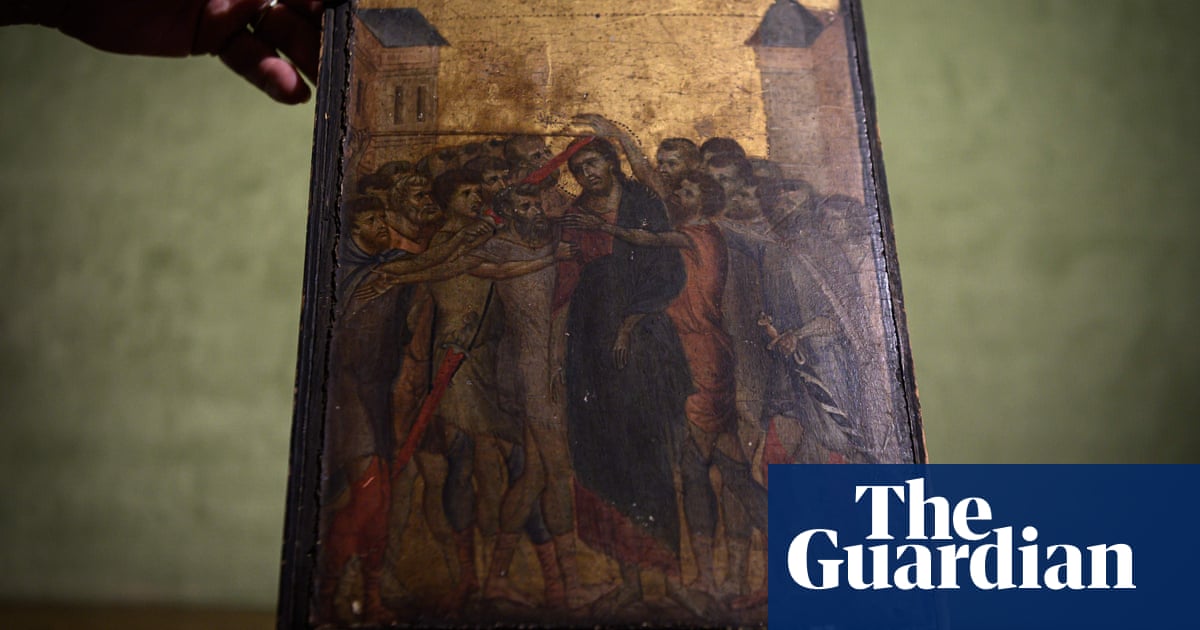Woman discovers Renaissance masterpiece in kitchen

An early Renaissance masterpiece by the Florentine painter Cimabue has been discovered in a kitchen on the outskirts of a town north of Paris, where it might have been binned during a house clearance if an auctioneer had not spotted it.
Christ Mocked, by the 13th-century artist who taught Giotto, is estimated to be worth €4m-€6m (£3.5m-£5.3m).
The work had for years gone unnoticed in the house of a woman in her 90s near the northern French town of Compiègne. It had been hanging between her open-plan kitchen and her living room, arousing little interest from the family, who assumed it was a standard religious icon. Although it was placed directly above a hotplate for cooking food, the picture was in good condition.
In June this year, when the woman decided to sell her house and move away, an expert at an auctioneers in Senlis was contacted to look at the contents, furniture and furnishings of the 1960s-built house in case some of it could be sold.
“I had a week to give an expert view on the house contents and empty it,” Philomène Wolf told Le Parisien. “I had to make room in my schedule … if I didn’t, then everything was due to go to the dump.”
Wolf said she spotted the painting as soon as she entered the house. “You rarely see something of such quality. I immediately thought it was a work of Italian primitivism. But I didn’t imagine it was a Cimabue.”
The auctioneer, who began her job at the auction house only last year, suggested the woman bring the painting, measuring 20cm by 24cm, to experts for an evaluation. She thought there might be a sale price of €300,000-€400,000.
Paris art experts were then contacted to give their view on the painting’s origin and it was valued at millions. About 100 other objects from the house were sold for around €6,000 and the remaining furniture and decorations were disposed of at the local dump.
The woman and her family have insisted on remaining anonymous. But they told the auction house that for years they had thought it was simply a old religious icon from Russia. The painting had hung on the wall for so long that the women said she no idea where it had come from or how it had come into the family’s hands.
The painting was deemed to be a rare work by the Florence-born Cimabue, also known as Cenni di Pepo, one of the pioneering artists of the early Italian Renaissance. Only 11 works painted on wood have been attributed to him, none of them signed.
It is thought to be part of a large diptych dating from 1280, when Cimabue painted eight scenes depicting Christ’s passion and crucifixion.
Two scenes from the same diptych, known as The Virgin and Child with Two Angels and The Flagellation of Christ, already hang in the National Gallery in London and the Frick Collection in New York respectively.
The well-preserved scene in the National Gallery was also lost for centuries, and found only when a British aristocrat was clearing his ancestral home near Lowestoft in Suffolk. It had been hanging unnoticed on a landing in the country house, where staff had no idea of its significance or value. It was given to the nation in 2000.
The National Gallery described Cimabue’s work as representing “a crucial moment in the history of art” when Italian painters, while still influenced by Byzantine painting, were exploring the naturalistic depiction of forms and three-dimensional space.
Early Renaissance art was hugely influenced by Byzantine art, which is still produced in a similar style today on a background of gold paint.
The French art expert Eric Turquin, who studied and valued the painting, said tests using infrared light found that there was “no disputing that the painting was done by the same hand” as other known works by Cimabue.
The painting from the kitchen will be sold by the Acteon auction house in Senlis on 27 October.
from Hacker News https://ift.tt/2kEBuJ4